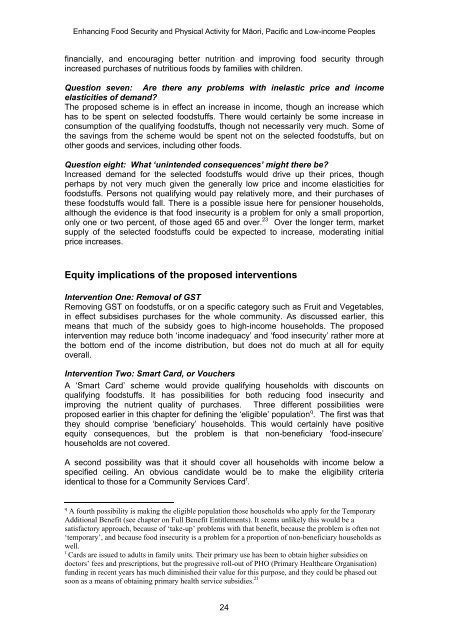enhancing food security and physical activity for maori, pacific and ...
enhancing food security and physical activity for maori, pacific and ...
enhancing food security and physical activity for maori, pacific and ...
- No tags were found...
You also want an ePaper? Increase the reach of your titles
YUMPU automatically turns print PDFs into web optimized ePapers that Google loves.
Enhancing Food Security <strong>and</strong> Physical Activity <strong>for</strong> Māori, Pacific <strong>and</strong> Low-income Peoplesfinancially, <strong>and</strong> encouraging better nutrition <strong>and</strong> improving <strong>food</strong> <strong>security</strong> throughincreased purchases of nutritious <strong>food</strong>s by families with children.Question seven: Are there any problems with inelastic price <strong>and</strong> incomeelasticities of dem<strong>and</strong>?The proposed scheme is in effect an increase in income, though an increase whichhas to be spent on selected <strong>food</strong>stuffs. There would certainly be some increase inconsumption of the qualifying <strong>food</strong>stuffs, though not necessarily very much. Some ofthe savings from the scheme would be spent not on the selected <strong>food</strong>stuffs, but onother goods <strong>and</strong> services, including other <strong>food</strong>s.Question eight: What ‘unintended consequences’ might there be?Increased dem<strong>and</strong> <strong>for</strong> the selected <strong>food</strong>stuffs would drive up their prices, thoughperhaps by not very much given the generally low price <strong>and</strong> income elasticities <strong>for</strong><strong>food</strong>stuffs. Persons not qualifying would pay relatively more, <strong>and</strong> their purchases ofthese <strong>food</strong>stuffs would fall. There is a possible issue here <strong>for</strong> pensioner households,although the evidence is that <strong>food</strong> in<strong>security</strong> is a problem <strong>for</strong> only a small proportion,only one or two percent, of those aged 65 <strong>and</strong> over. 23 Over the longer term, marketsupply of the selected <strong>food</strong>stuffs could be expected to increase, moderating initialprice increases.Equity implications of the proposed interventionsIntervention One: Removal of GSTRemoving GST on <strong>food</strong>stuffs, or on a specific category such as Fruit <strong>and</strong> Vegetables,in effect subsidises purchases <strong>for</strong> the whole community. As discussed earlier, thismeans that much of the subsidy goes to high-income households. The proposedintervention may reduce both ‘income inadequacy’ <strong>and</strong> ‘<strong>food</strong> in<strong>security</strong>’ rather more atthe bottom end of the income distribution, but does not do much at all <strong>for</strong> equityoverall.Intervention Two: Smart Card, or VouchersA ‘Smart Card’ scheme would provide qualifying households with discounts onqualifying <strong>food</strong>stuffs. It has possibilities <strong>for</strong> both reducing <strong>food</strong> in<strong>security</strong> <strong>and</strong>improving the nutrient quality of purchases. Three different possibilities wereproposed earlier in this chapter <strong>for</strong> defining the ‘eligible’ population q . The first was thatthey should comprise ‘beneficiary’ households. This would certainly have positiveequity consequences, but the problem is that non-beneficiary ‘<strong>food</strong>-insecure’households are not covered.A second possibility was that it should cover all households with income below aspecified ceiling. An obvious c<strong>and</strong>idate would be to make the eligibility criteriaidentical to those <strong>for</strong> a Community Services Card r .q A fourth possibility is making the eligible population those households who apply <strong>for</strong> the TemporaryAdditional Benefit (see chapter on Full Benefit Entitlements). It seems unlikely this would be asatisfactory approach, because of ‘take-up’ problems with that benefit, because the problem is often not‘temporary’, <strong>and</strong> because <strong>food</strong> in<strong>security</strong> is a problem <strong>for</strong> a proportion of non-beneficiary households aswell.r Cards are issued to adults in family units. Their primary use has been to obtain higher subsidies ondoctors’ fees <strong>and</strong> prescriptions, but the progressive roll-out of PHO (Primary Healthcare Organisation)funding in recent years has much diminished their value <strong>for</strong> this purpose, <strong>and</strong> they could be phased outsoon as a means of obtaining primary health service subsidies. 2124
















